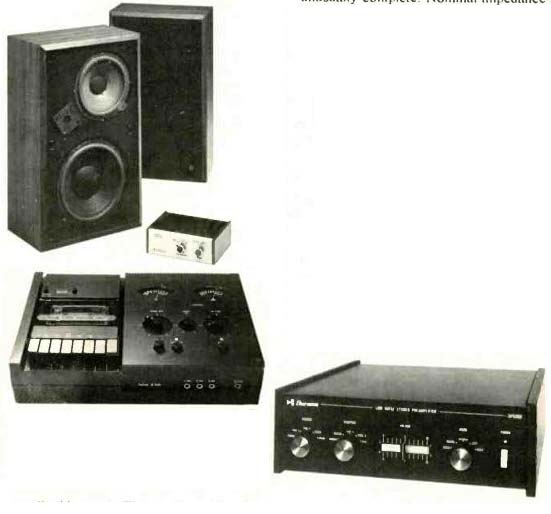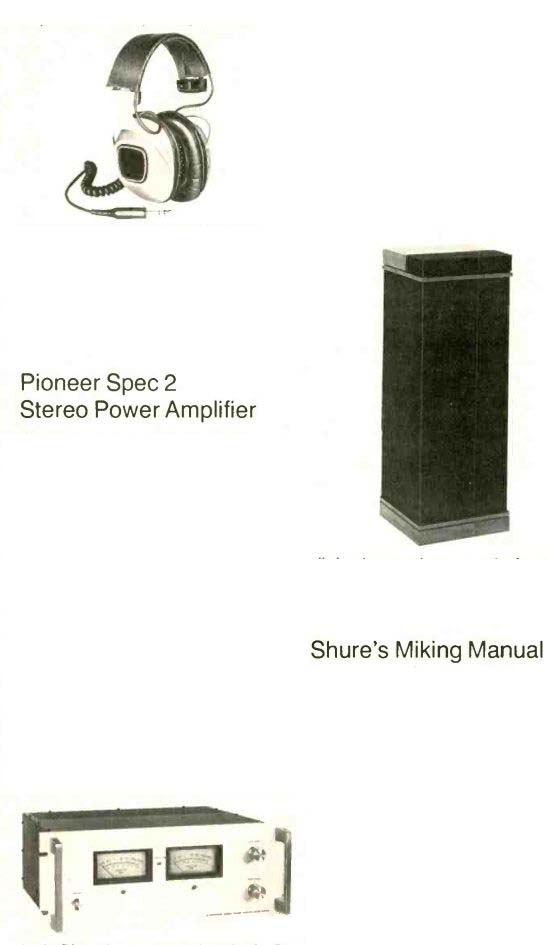
THE LATEST IN HIGH-FIDELITY EQUIPMENT
Sonab C500 Stereo Cassette Deck
A new import from Sweden, the Sonab 0500 cassette deck, has Dolby B-Type noise reduction, switchable bias and equalization for standard and chromium-dioxide tapes, three microphone inputs (left, right, and center) with separate level controls for each, and modern European styling. The transport key board provides the customary functions of re cord, play, rewind, fast forward, pause, and stop/eject, while a memory function permits a fast, automatic return to any preselected point on the tape. The rest of the controls consist of pushbuttons for power, Dolby noise reduction, and tape type, and knob adjustments (concentrically mounted for the two channels) for recording and playback levels. The two recording-level meters are peak-reading devices.
Rated frequency response for the Sonab C500 is 30 to 15,000 Hz with standard tape, 30 to 16,000 Hz with chromium dioxide. Wow and flutter (weighted) are below 0.13 percent, and signal-to-noise ratios are 60 dB with Dolby, 53 dB without (both figures using chromium-dioxide tape). The corresponding figures for standard tape are 58 and 51 dB. The C500 is finished entirely in black; it has dimensions of 15 x 10 x 4 inches. Price: $399.
Electro-Voice Interface:B Speaker System
Following the design of the successful Interface:A, Electro-Voice's Interface:B is also an equalized speaker system of two-way design employing a passive low-frequency radiator the company calls a "vent substitute" plus an 8-inch woofer and a dome tweeter of nominal 2 1/2-inch diameter. However, the Model B is a bit larger than its predecessor (23 x 14 x 9 1/4 inches), 3 dB more efficient, and about $60 less expensive ($325 per pair, including the equalizer).
The Interface:B obtains its higher efficiency through a redesigned woofer and the slightly larger enclosure, and by sacrificing 4 Hz of lowest bass response. On-axis frequency response is 36 to 18,000 Hz ±3 dB, while total acoustic-power output is uniform within 4 1/2 dB over the same range. Below 55 Hz the out put of the passive radiator begins to predominate, and at 39 Hz the active equalizer pro vides its maximum bass boost of 6 dB. Below 36 Hz the equalizer introduces a rolloff to eliminate turntable rumble and other subsonic signals. The tweeter's output at 10,000 Hz is adjustable over a 6-dB range in three switch positions.
The specifications for the Interface:B are unusually complete. Nominal impedance is 8 ohms (5 ohms minimum), and the sensitivity rating is 92 dB sound-pressure level at one meter for an electrical input of 1 watt. Power-handling capability at mid-frequencies is 18 watts indefinitely, 180 watts for periods not exceeding 10 milliseconds. Minimum suggest ed amplifier power is 5 watts per channel, which should be adequate for average sound-pressure levels of 93 dB in the reverberant field of a typical listening room. Maximum recommended amplifier power is 180 watts per channel for average sound-pressure levels of 107 dB under the same conditions.
The crossover frequency for the system is 1,500 Hz. The equalizer unit has an input impedance of 100,000 ohms, unity gain at mid-frequencies, and a maximum output of 5 volts at any frequency. Harmonic and inter-modulation distortion are 0.05 and 0.005 percent, respectively, for an input of 1.5 volts.
The noise level is 80 dB below an output of 200 millivolts. The equalizer is meant to be in stalled between the preamplifier and power amplifier or in the tape-monitor loop of an integrated amplifier or receiver. (Tape-monitor jacks and switching are provided to replace those taken up by its installation.) The equalizer case measures 8 x 2 3/4 x 7 inches. The speaker enclosures themselves are clad in walnut-finish vinyl with dark grilles.
Burwen Model SP 5200 Stereo Preamplifier
The SP 5200 from Burwen Laboratories is a low-noise stereo preamplifier affording a dynamic range of 115 dB under typical use conditions. Through the high-level section, noise in the range from 20 to 20,000 Hz is 95 dB be low the rated output of 2.5 volts; the signal-to noise ratio for the phono section is 90 dB, referred to an input of 10 millivolts. Total harmonic distortion within the audio range is a maximum of 0.05 percent at rated output.
The SP 5200 has no tone controls or filters, providing only gain and signal-switching facilities for the two channels of audio. However, the very elaborate bank of inputs and outputs includes jacks for two external signal processors (an equalizer and a dynamic noise filter, for example) plus a speaker-system equalizer as well as inputs and outputs for two tape decks, three other high-level sources, and phono cartridge. There is also an output for a third "center-fill" speaker channel governed by its own level control. The tape-monitor switching on the front panel permits listening to the recording signal as it comes from the program source, the playback signal from the tape deck, or the recording signal after it has passed through whatever signal processors are connected to the SP 5200 but before it is recorded. Other controls include two slider-type closely matched volume controls for the two channels (they also establish stereo balance) and a mode switch with positions for mono, stereo, reversed stereo, or either channel alone.
The phono section of the SP 5200 employs an FET input stage. The load resistance for the cartridge is provided by an adjustable feedback circuit that makes it possible to re duce thermal noise contributed by the cartridge to a minimum for most magnetic pick ups. The gain of the phono section is also adjustable (over a 23-dB range), permitting the use of any magnetic cartridge with the preamplifier. The Burwen SP 5200 is finished in black metal with wood end pieces. The rear panel, with its jacks, controls, and five a.c. convenience outlets (one unswitched), is recessed into the cabinet. Approximate dimensions are 14 1/2 x 5 x inches. Price: $489.95.

ESS Phase 1 Stereo Headphones
The first application of the ESS-Heil Air-Motion Transformer to headphones is now avail able as the Phase 1 stereo headset. Each ear piece contains a miniature full-range Heil driver utilizing a diaphragm folded to produce pleats of varying depth. The rear radiations of the drivers are open to the air, so that the phones do not isolate the listener from outside sounds. Circum-aural cushions of plastic-covered foam are fitted to each earpiece, and the earpieces are suspended from the extendable headband by pivoting yokes.
The Phase I headphones must be connected directly to the speaker terminals of an amplifier or receiver (any amplifier capable of driving loudspeakers should be adequate). They present a load impedance of 32 ohms and can tolerate an input of up to 14 volts. Frequency response is 20 to 50,000 Hz, and distortion is Tr' rated at 0.3 percent for a 90-dB sound-pres sure level at 1,000 Hz. An integral 14-foot coiled cable ends in a standard three-conductor stereo phone plug, for which there is an adapter that connects directly to the speaker terminals. The phones weigh 14 ounces exclusive of the cable. Price: $97.
Pioneer Spec 2 Stereo Power Amplifier
Pioneer has introduced its first basic power amplifier to the U.S. market. The Spec 2 is rated at a continuous output of 250 watts per channel with less than 0.1 percent harmonic or intermodulation distortion. Rated power is available with either 4- or 8-ohm loads, and for any frequency from 20 to 20,000 Hz. Hum and noise are 110 dB below rated output, which is obtained with I volt into the amplifier's minimum input impedance of 50,000 ohms. The damping factor (8-ohm load) is 70 at any audio frequency.
The Spec 2 contains a total of five relays that provide reliable protection for internal circuits and prevent turn-on surges or other potentially hazardous signals from reaching the speaker systems. Peak-reading output-level meters on the front panel are driven by logarithmic amplifiers that permit the power range from 0.01 to 500 watts to be accommodated on the meter scales. (The meters are also calibrated in decibels.) Gain controls for each channel are also provided, and there is a switch to select operation with 8- or 4-ohm loads. Dimensions are approximately 19 x 7 x 16 1/4 inches; the front panel has slots to permit rack mounting as well as grab handles. Price: $899.95.
Design Acoustics D-2 Speaker System
The latest Design Acoustics speaker, the D-2, is a two-way system with a 10-inch woofer and 1-inch dome tweeter installed in a black grille-covered columnar enclosure with walnut trim. The tweeter's axis is at a 60-degree angle from the horizontal, so that it radiates upward and slightly forward into the listening area. The woofer is mounted below, facing forward, and at a sufficient distance from the tweeter to prevent acoustical interference with it. Within its sealed enclosure the woofer has a resonance frequency of 41 Hz.
The total acoustical power output of the D-2 is 40 to 18,000 Hz ±3.5 dB. Nominal impedance is 8 ohms, and the range of recommended amplifier powers for the system is 20 to 50 watts per channel. Crossover between woofer and tweeter occurs at a frequency of 1,500 Hz. The cross-sectional dimensions of the cabinet are 12 1/2 x 12 1/4 inches. The system stands 35 inches high and is topped with an oiled walnut panel except at the front edge, where a foam grille section covers the tweeter. Price: $150.
Shure's Miking Manual
The Music-maker's Manual of Microphone Mastery, available free of charge from Shure Brothers, is a practical and explicit guide to useful microphone techniques for various specific instruments. The instruments-voice, piano, acoustic and electric guitars, drums, and brass, among others-are taken up in turn, their particular problems discussed, and suggestions made for optimum microphone type and placement. Shure microphones are recommended by model number for all these applications, but since the desirable characteristics are fully explained, the information can be applied to other microphone brands as well. The manual also notes accessories that are convenient or necessary for achieving the best possible results.
Although the Shure manual is written with "live" sound-reinforcement purposes in mind, the recordist should also find the material of great assistance. In booklet form, the manual is printed on 8 1/2 x 11-inch stock and runs some ten pages in length. To order, re quest brochure AL 493 from: Shure Brothers Inc., Dept. SR, 222 Hartrey Avenue, Evanston, Ill. 60204.
PUBLISHER'S NOTICE: Recent fluctuations in the value of the dollar will have an effect on the price of merchandise imported into this country. So, please be aware that the prices quoted in this issue may be subject to change.
Also see:
Source: Stereo Review (USA magazine)